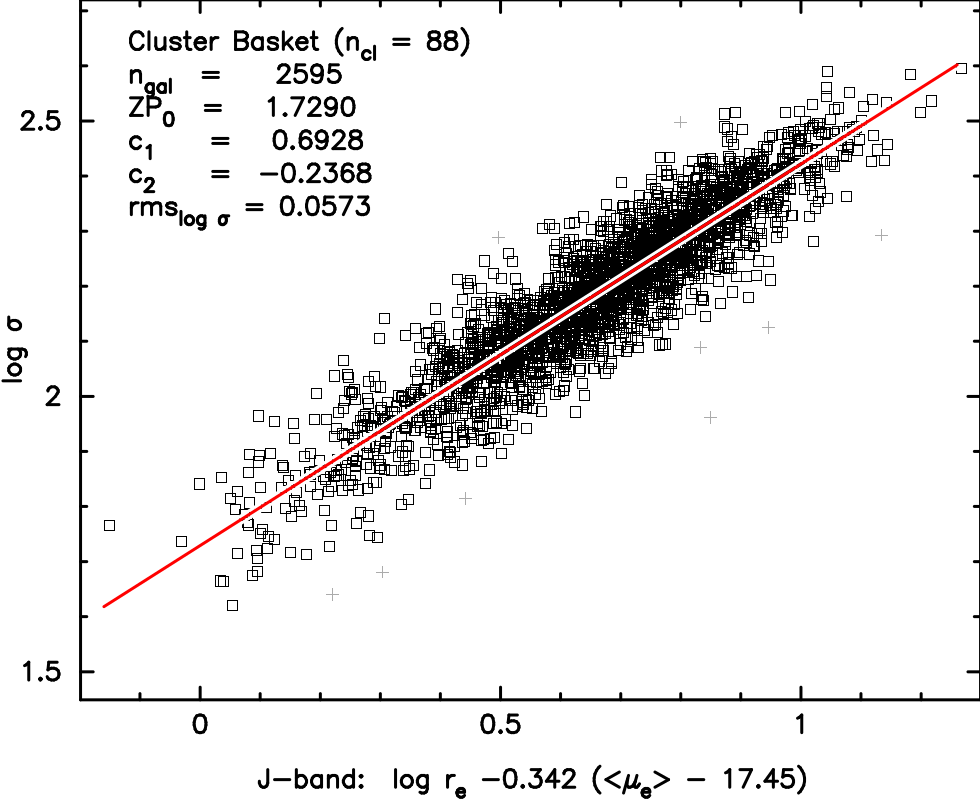Construction and Exploitation of new FP-based peculiar velocity surveys
Our 6dFGS project (Jones et al. 2009) measured ∼110,000 redshifts in the southern hemisphere in order to identify and quantify the key nearby large-scale local structures. In parallel to 6dFGS we undertook a peculiar velocity survey measuring the distances to ∼9,000 early-type galaxies with z < 0.055 using the Fundamental Plane (FP). The key results achieved included (a) construction and characterisation of the near-IR (2MASS-based) FP (Campbell et al. 2014, Magoulas et al. 2012), (b) determination of the systematic stellar population trends on the FP ( Springob et al. 2012), (c) Bayesian-based peculiar velocity measurements ( Springob et al. 2014) and (d) the determination of the cosmological constraints and the bulk flow (Johnson et al. 2014, Scrimgeour et al. 2016).
While in recent years much progress has been made in mapping the local peculiar velocity field, there are several key issues that are still poorly known, e.g. the precise source of the Local Group motion with respect to the Cosmic Microwave Background, the bulk flow amplitude at large scales which is a sensitive probe of matter density fluctuations. We are working on two new large peculiar velocity surveys, i.e. TAIPAN and LoRCA, that will dramatically improve the local FP dataset both in terms of data quality, the numbers of objects and sky coverage.
 |
| The global Fundamental Plane for our sample of 88 rich clusters. Galaxies included in the fit are plotted as black squares (n = 2595). Clusters have been shifted together, using to a common reference distance equivalent to a redshift distance of z = 0.024. Distance errors per galaxy of 19% are achieved. |
TAIPAN (www.taipan-survey.org) is a southern sky, multi-object spectroscopic survey which will obtain redshifts for a million galaxies and is being undertaken on the refurbished UKST with a new dedicated spectrograph. The peculiar velocity part of TAIPAN follows in the footsteps of 6dFGS and will provide high quality FP distance measurements for ∼50,000 early-type galaxies with z < 0.07. The first TAIPAN observations are scheduled for mid-2016. "Low Redshift survey at Calar Alto" (LoRCA) is a northern hemisphere project that is highly complementary survey to TAIPAN (see Comparat et al. 2015) and will provide FP distance measurements for ∼20,000 early-type galaxies. TAIPAN and LoRCA supplemented by the existing large FP studies (6dFGS, SDSS, NFPS, ENEAR, SMAC, etc) will provide a comprehensive map of the local velocity field with sufficient accuracy and resolution to solve the key outstanding issues.
Our key role in TAIPAN and LoRCA is the construction of the multi-band FP photometry measurements combining optical measurements from Pan-STARRS, SDSS, VST ATLAS with NIR measurements from 2MASS and VHS, plus the detailed analysis of SDSS-based FP measurements. As a "path-finder" for this work using published velocity dispersions and new 2MASS-based FP photometry parameters, we have constructed an all-sky set of FP-based distances to 88 nearby clusters (z = 0.041). Distance errors of 19% per galaxy were achieved (see Figure) which demonstrates that high quality distance measurements can achieved.
Staff involved with this project at Durham include John Lucey.
Contact Details
Centre for Extragalactic Astronomy,Ogden Centre for Fundament Physics - West,
Department of Physics,
Durham University,
South Road,
Durham DH1 3LE
Tel: 44 (0)191 3343635





